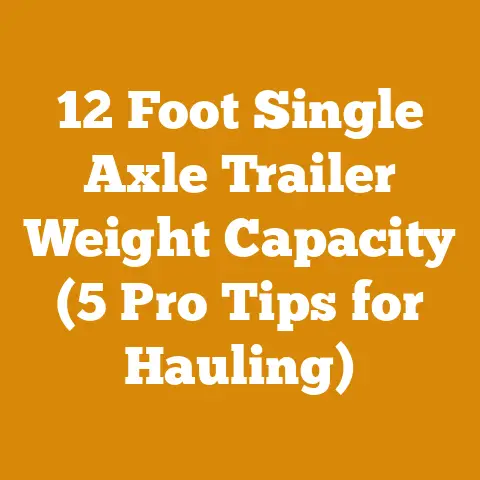Tree Cutting Insurance Costs (5 Expert Tips for Arborists)
Navigating the Treacherous Terrain: Tree Cutting Insurance Costs (5 Expert Tips for Arborists)
1. Understanding the Tree-Cutting Insurance Landscape
Before diving into specific tips, it’s crucial to understand the different types of insurance you’ll likely encounter as an arborist. Think of it as surveying the terrain before you start felling trees – you need to know what you’re up against.
- General Liability Insurance: This is your bread and butter. It covers bodily injury and property damage caused by your operations. Imagine a falling limb damaging a neighbor’s car – general liability steps in.
- Workers’ Compensation Insurance: If you have employees (and even if you’re a sole proprietor in some states!), workers’ comp is essential. It covers medical expenses and lost wages for employees injured on the job. Trust me, a chainsaw slip-up can be devastating, and this insurance protects both you and your team. According to the National Safety Council, the construction and extraction occupational group, which includes logging and tree trimming, has the highest rate of nonfatal injuries and illnesses involving days away from work.
- Commercial Auto Insurance: Your trucks, chippers, and other vehicles need coverage. Personal auto insurance won’t cut it when you’re using your vehicles for business.
- Professional Liability Insurance (Errors and Omissions): Also known as E&O insurance, this protects you against claims of negligence or errors in your professional advice. For example, if you misdiagnose a tree’s health and it later falls, causing damage, E&O insurance can cover the resulting costs.
- Equipment Insurance (Inland Marine): This covers your valuable equipment, like chainsaws, chippers, and climbing gear, against theft, damage, or loss.
- Umbrella Insurance: Provides an extra layer of liability coverage above your other policies. It’s like having a safety net in case of a catastrophic event.
2. Tip #1: Assess Your Risks Like a Seasoned Arborist
Insurance premiums are directly tied to risk. The more risk you represent to an insurance company, the higher your rates will be. Therefore, the first step in managing your insurance costs is to thoroughly assess your risks.
- Location, Location, Location: Where you operate significantly impacts your risk profile. Urban environments with dense populations and valuable properties are riskier than rural areas. Coastal regions are subject to hurricanes and storms, increasing the likelihood of tree damage and insurance claims.
- Type of Work: Certain types of tree work are inherently riskier. Tree removals, especially those involving large, hazardous trees near power lines, carry a higher risk than routine pruning. Specialized services like crane-assisted removals or working near railways also increase your risk profile.
- Equipment and Techniques: The equipment you use and the techniques you employ can influence your risk. Using outdated or poorly maintained equipment increases the likelihood of accidents. Similarly, failing to adhere to industry best practices and safety standards raises your risk.
- Employee Training and Experience: A well-trained and experienced crew is less likely to have accidents. Invest in ongoing training for your employees, focusing on safety procedures, equipment operation, and hazard identification.
- Claims History: Your past claims history is a major factor in determining your insurance rates. A history of frequent or costly claims will make you a less attractive risk to insurers.
My Experience: I once worked a job where a seemingly simple removal turned into a nightmare. The tree was larger than we anticipated, and the ground was softer than it looked. Long story short, the tree fell in a way that damaged a fence and barely missed a house. Thankfully, we had the right insurance, but the experience taught me the importance of meticulous risk assessment. Now, I always over-prepare and double-check everything before starting a job.
Actionable Steps:
- Conduct a Risk Assessment: Create a checklist to identify potential hazards on each job site. Consider factors like tree size, proximity to structures, ground conditions, and weather conditions.
- Implement Safety Protocols: Develop and enforce strict safety protocols for all aspects of your operations. Regularly review and update these protocols to reflect industry best practices.
- Maintain Equipment: Regularly inspect and maintain your equipment to ensure it is in good working order. Keep detailed maintenance records.
- Invest in Training: Provide ongoing training for your employees on safety procedures, equipment operation, and hazard identification.
3. Tip #2: Shop Around and Compare Quotes Diligently
Don’t settle for the first insurance quote you receive. Insurance companies vary in their risk appetite, pricing models, and coverage options. Shopping around and comparing quotes from multiple insurers is essential to finding the best deal.
- Independent Insurance Agents: Work with an independent insurance agent who specializes in the tree care industry. These agents have access to multiple insurance companies and can help you find the right coverage at the best price. They understand the unique risks faced by arborists and can tailor a policy to your specific needs.
- Online Insurance Marketplaces: Explore online insurance marketplaces that allow you to compare quotes from multiple insurers simultaneously. These marketplaces can save you time and effort in your search for insurance.
- Direct Insurers: Consider getting quotes directly from insurance companies that specialize in commercial insurance. Some insurers may offer better rates or coverage options than those available through agents or marketplaces.
- Compare Apples to Apples: When comparing quotes, make sure you’re comparing the same coverage limits, deductibles, and policy terms. Don’t be swayed by a lower premium if it comes with significantly less coverage.
- Read the Fine Print: Carefully review the policy terms and conditions to understand what is covered and what is excluded. Pay attention to any exclusions that may be relevant to your operations.
Data Point: According to a study by the Small Business Administration (SBA), small businesses that shop around for insurance can save up to 20% on their premiums.
My Experience: When I first started my business, I made the mistake of going with the first insurance agent I found. I didn’t realize there were agents who specialized in the tree care industry. After a few years, I switched to an independent agent who understood my business and was able to find me a better policy at a lower price.
Actionable Steps:
- Contact at Least Three Insurers: Get quotes from at least three different insurance companies or agents.
- Provide Accurate Information: Be honest and accurate when providing information to insurers. Misrepresenting your business or operations can lead to denied claims or policy cancellation.
- Request a Coverage Review: Ask your insurance agent to review your coverage annually to ensure it still meets your needs.
4. Tip #3: Leverage Safety Programs and Certifications
Actionable Steps:
Even with the best risk management practices, accidents can still happen. How you manage claims can significantly impact your future insurance rates.
- Report Claims Promptly: Report all claims to your insurance company as soon as possible, even if you’re not sure whether the claim will be covered. Delaying reporting can jeopardize your coverage.
- Cooperate with the Insurer: Cooperate fully with your insurance company’s investigation of the claim. Provide all requested information and documentation promptly.
- Document Everything: Keep detailed records of all accidents, injuries, and property damage. Document the circumstances of the incident, the people involved, and the steps taken to address the situation.
- Implement Corrective Actions: After a claim, take steps to prevent similar incidents from happening in the future. Review your safety protocols, retrain employees, and address any underlying issues that contributed to the accident.
- Negotiate Settlements: Work with your insurance company to negotiate fair and reasonable settlements for claims. Don’t hesitate to seek legal advice if you’re not satisfied with the insurer’s offer.
Case Study: A tree care company experienced a series of claims related to falling limbs damaging vehicles. After each claim, the company implemented corrective actions, such as improving tree risk assessments, reinforcing safety protocols for limb removal, and investing in better communication equipment. Over time, the company’s claims history improved, and its insurance premiums decreased.
My Experience: Early in my career, I made the mistake of trying to handle a small claim myself without involving my insurance company. It ended up costing me more in the long run, both in terms of money and time. Now, I always report claims promptly and work closely with my insurer to resolve them efficiently.
Actionable Steps:
- Establish a Claims Reporting Procedure: Develop a clear procedure for reporting claims to your insurance company.
- Train Employees on Claims Reporting: Train your employees on how to report claims and what information to provide.
- Review Claims History Regularly: Review your claims history regularly to identify trends and potential areas for improvement.
- Seek Professional Advice: Consult with a legal or insurance professional if you have questions or concerns about a claim.
6. Tip #5: Optimize Your Coverage and Deductibles
Finding the right balance between coverage and cost is crucial. You want to ensure you have adequate protection without overpaying for insurance you don’t need.
- Coverage Limits: Determine the appropriate coverage limits for each type of insurance based on your risk assessment. Consider factors such as the value of your equipment, the potential liability exposure, and the frequency of claims.
- Deductibles: Choose deductibles that you can comfortably afford to pay out of pocket in the event of a claim. Higher deductibles typically result in lower premiums, but you’ll need to be prepared to pay more if you have a claim.
- Policy Endorsements: Consider adding endorsements to your policy to tailor the coverage to your specific needs. For example, you may want to add an endorsement to cover damage to underground utilities or to provide coverage for work performed on railroad property.
- Bundling Policies: Consider bundling your insurance policies with the same insurer. Many insurers offer discounts for bundling multiple policies, such as general liability, workers’ compensation, and commercial auto.
- Payment Options: Explore different payment options offered by your insurer. Some insurers offer discounts for paying your premium in full upfront or for setting up automatic payments.
Data Point: According to a survey by the National Federation of Independent Business (NFIB), small business owners spend an average of 2% of their gross revenue on insurance.
My Experience: I initially chose the lowest possible deductibles to minimize my out-of-pocket expenses. However, I realized that I was paying significantly higher premiums for that peace of mind. After consulting with my insurance agent, I increased my deductibles and saved a substantial amount of money on my premiums.
Actionable Steps:
- Review Coverage Limits Annually: Review your coverage limits annually to ensure they still meet your needs.
- Adjust Deductibles Strategically: Adjust your deductibles based on your risk tolerance and financial situation.
- Explore Policy Endorsements: Explore policy endorsements to tailor your coverage to your specific needs.
- Bundle Insurance Policies: Bundle your insurance policies with the same insurer to take advantage of discounts.
Bonus Tip: Documentation is Your Best Friend
In the world of tree care, meticulous documentation is your shield. It’s the evidence that supports your claims, protects your business, and demonstrates your commitment to safety and professionalism.
While insurance is a vital safety net, it’s not a substitute for proactive risk management. The best way to manage your insurance costs is to prevent accidents from happening in the first place. Invest in safety training, maintain your equipment, follow industry best practices, and prioritize the well-being of your employees. By creating a culture of safety, you’ll not only reduce your insurance costs but also protect your business and your reputation.
Key Takeaways and Next Steps:
- Understand your risks: Assess your operations to identify potential hazards.
- Shop around: Compare quotes from multiple insurers.
- Invest in safety: Implement safety programs and obtain certifications.
- Manage claims effectively: Report claims promptly and cooperate with the insurer.
- Optimize coverage: Choose the right coverage limits and deductibles.
- Document everything: Maintain detailed records of all aspects of your operations.
By following these tips, you can navigate the complex world of tree-cutting insurance and protect your business from financial ruin. Remember, investing in the right insurance coverage is an investment in your future. Now, go forth, be safe, and may your chainsaws always be sharp (and your insurance premiums low!).






